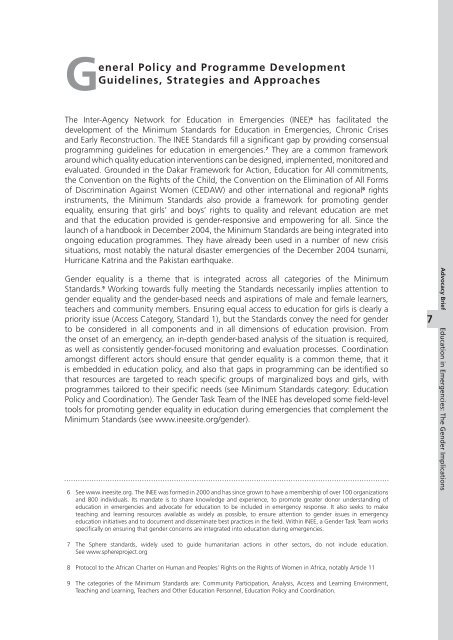Education in Emergencies: The Gender Implications - INEE
Education in Emergencies: The Gender Implications - INEE
Education in Emergencies: The Gender Implications - INEE
- No tags were found...
Create successful ePaper yourself
Turn your PDF publications into a flip-book with our unique Google optimized e-Paper software.
General Policy and Programme DevelopmentGuidel<strong>in</strong>es, Strategies and Approaches<strong>The</strong> Inter-Agency Network for <strong>Education</strong> <strong>in</strong> <strong>Emergencies</strong> (<strong>INEE</strong>) has facilitated thedevelopment of the M<strong>in</strong>imum Standards for <strong>Education</strong> <strong>in</strong> <strong>Emergencies</strong>, Chronic Crisesand Early Reconstruction. <strong>The</strong> <strong>INEE</strong> Standards fill a significant gap by provid<strong>in</strong>g consensualprogramm<strong>in</strong>g guidel<strong>in</strong>es for education <strong>in</strong> emergencies. <strong>The</strong>y are a common frameworkaround which quality education <strong>in</strong>terventions can be designed, implemented, monitored andevaluated. Grounded <strong>in</strong> the Dakar Framework for Action, <strong>Education</strong> for All commitments,the Convention on the Rights of the Child, the Convention on the Elim<strong>in</strong>ation of All Formsof Discrim<strong>in</strong>ation Aga<strong>in</strong>st Women (CEDAW) and other <strong>in</strong>ternational and regional rights<strong>in</strong>struments, the M<strong>in</strong>imum Standards also provide a framework for promot<strong>in</strong>g genderequality, ensur<strong>in</strong>g that girls’ and boys’ rights to quality and relevant education are metand that the education provided is gender-responsive and empower<strong>in</strong>g for all. S<strong>in</strong>ce thelaunch of a handbook <strong>in</strong> December 2004, the M<strong>in</strong>imum Standards are be<strong>in</strong>g <strong>in</strong>tegrated <strong>in</strong>toongo<strong>in</strong>g education programmes. <strong>The</strong>y have already been used <strong>in</strong> a number of new crisissituations, most notably the natural disaster emergencies of the December 2004 tsunami,Hurricane Katr<strong>in</strong>a and the Pakistan earthquake.<strong>Gender</strong> equality is a theme that is <strong>in</strong>tegrated across all categories of the M<strong>in</strong>imumStandards. Work<strong>in</strong>g towards fully meet<strong>in</strong>g the Standards necessarily implies attention togender equality and the gender-based needs and aspirations of male and female learners,teachers and community members. Ensur<strong>in</strong>g equal access to education for girls is clearly apriority issue (Access Category, Standard 1), but the Standards convey the need for genderto be considered <strong>in</strong> all components and <strong>in</strong> all dimensions of education provision. Fromthe onset of an emergency, an <strong>in</strong>-depth gender-based analysis of the situation is required,as well as consistently gender-focused monitor<strong>in</strong>g and evaluation processes. Coord<strong>in</strong>ationamongst different actors should ensure that gender equality is a common theme, that itis embedded <strong>in</strong> education policy, and also that gaps <strong>in</strong> programm<strong>in</strong>g can be identified sothat resources are targeted to reach specific groups of marg<strong>in</strong>alized boys and girls, withprogrammes tailored to their specific needs (see M<strong>in</strong>imum Standards category: <strong>Education</strong>Policy and Coord<strong>in</strong>ation). <strong>The</strong> <strong>Gender</strong> Task Team of the <strong>INEE</strong> has developed some field-leveltools for promot<strong>in</strong>g gender equality <strong>in</strong> education dur<strong>in</strong>g emergencies that complement theM<strong>in</strong>imum Standards (see www.<strong>in</strong>eesite.org/gender).6 See www.<strong>in</strong>eesite.org. <strong>The</strong> <strong>INEE</strong> was formed <strong>in</strong> 2000 and has s<strong>in</strong>ce grown to have a membership of over 100 organizationsand 800 <strong>in</strong>dividuals. Its mandate is to share knowledge and experience, to promote greater donor understand<strong>in</strong>g ofeducation <strong>in</strong> emergencies and advocate for education to be <strong>in</strong>cluded <strong>in</strong> emergency response. It also seeks to maketeach<strong>in</strong>g and learn<strong>in</strong>g resources available as widely as possible, to ensure attention to gender issues <strong>in</strong> emergencyeducation <strong>in</strong>itiatives and to document and dissem<strong>in</strong>ate best practices <strong>in</strong> the field. With<strong>in</strong> <strong>INEE</strong>, a <strong>Gender</strong> Task Team worksspecifically on ensur<strong>in</strong>g that gender concerns are <strong>in</strong>tegrated <strong>in</strong>to education dur<strong>in</strong>g emergencies.7 <strong>The</strong> Sphere standards, widely used to guide humanitarian actions <strong>in</strong> other sectors, do not <strong>in</strong>clude education.See www.sphereproject.orgAdvocacy Brief <strong>Education</strong> <strong>in</strong> <strong>Emergencies</strong>: <strong>The</strong> <strong>Gender</strong> <strong>Implications</strong>8 Protocol to the African Charter on Human and Peoples’ Rights on the Rights of Women <strong>in</strong> Africa, notably Article 119 <strong>The</strong> categories of the M<strong>in</strong>imum Standards are: Community Participation, Analysis, Access and Learn<strong>in</strong>g Environment,Teach<strong>in</strong>g and Learn<strong>in</strong>g, Teachers and Other <strong>Education</strong> Personnel, <strong>Education</strong> Policy and Coord<strong>in</strong>ation.
















